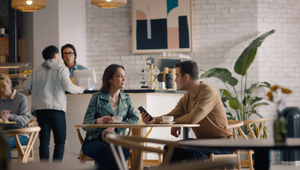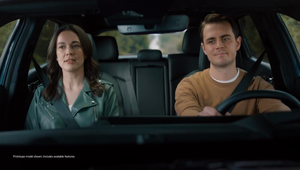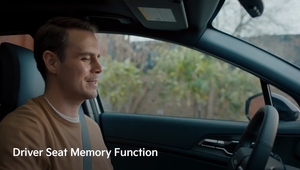
LBB Film Club: Barbara's Garden

Barbara's Garden is a portrait of an elderly immigrant couple living simply and sustainably in Canada, as they cultivate their garden. But it's also more than that. It's a beautiful, loving portrait of a filmmaker's parents, as Barbara and her husband are indeed the parents of Stash Capar, a director at Canadian production company Circle Productions. Stash had always been keen to capture his parents' true selves and eventually landed on their garden as the perfect metaphor to tell their story. The end result is this deeply personal film that will be undoubtedly relatable for countless others.
LBB's Addison Capper chatted with Stash to find out more about his parents and the process of making a film about them.
LBB> I was going to ask you who Barbara and her partner were but via some snooping on Vimeo I discovered they are your parents! Tell me a bit about their story - and their garden!
Stash> My parents are incredible people. I would need a separate interview to outline the reasons why. To make a long story short, despite all of life’s curveballs, they’ve always found a way to do good and maintain a positive outlook on humanity, while expecting nothing and being ready for the worst case scenario. They are a living embodiment of the Voltaire quote that wraps up the film.
When it comes to their garden - food gardens have always been important to them, not out of a sense of hobbyism, but rather out of necessity. Growing up they were used to food shortages and a functional food garden was a way to lessen uncertainty and bring back a sense of control and peace to their lives. When they immigrated to Canada, their mindset didn’t change despite now being in a more developed and wealthier part of the world.
What’s beautiful about their garden is that it’s simultaneously useful, a source of great pleasure, a source of community (they give away so much food!), and a shared project that brings my parents together. My mother jokes that the garden is her third child, after my brother and I.
LBB> What inspired you to make a film about them? And, more specifically, why did you decide to hook it around their garden and the sustainability that it offers?
Stash> I always wanted to find a way to capture the essence of my parents in moving images and the garden is such a nice metaphor for who they are and how they live their lives.
On a darker and more personal note - I have no memory of my grandparents, just a handful of black and white photos and some oral stories. I’m happy that this short film captures the spirit of my parents, should history repeat itself and my future children won’t get a chance to meet their grandparents either. I don’t think that will be the case, but like my parents, I like to plan for the worst and hope for the best.
LBB> Once you were fixed on an angle, what was the process like after that? How did you go about writing and getting everything ready for what you wanted to capture?
Stash> It happened very quickly. From concept to delivery in something like a week. Once I had the spark of the idea in my mind, I called up Darrin [Klimek, cinematographer] and loosely described what I was thinking. We were scouting the next day.
I remember taking Darrin through the garden and basically just describing, as a son, the rituals of my parents. I know that my mother waters the kale in the front yard early in the morning, as the sun rises. I know that my father works the soil in the backyard in the late afternoon as golden light hits the fruit trees. The shots were right there. I just had to translate my insights, as their son, into something that we could capture.
LBB> I pick up so much warmth in all aspects of the film but especially the cinematography and colour grade - how did you pull that off? What were your overall aims and ambitions from an aesthetic point of view?
Stash> Everything was about being in the right place at exactly the right time, and then just finessing what was naturally there, both in production and in post. I tried to be as honest and emotionally authentic as possible and I think you can see that in the end product. At the end of the day, it’s a son capturing a loving portrait of his parents.
LBB> What was the actual production like? What went down?
Stash> It was hectic and physically demanding. Darrin was a one man camera department, I was directing and talent wrangling (a big job). We shared grip responsibilities, meaning running around, putting up ladders, scampering on hot rooftops and basically getting a solid workout in.
Then we would have these long breaks as we waited for the sun to get into the right position or for my dad to wake up from a nap. During this time my mother would spoil us with food and drink. Then, suddenly, back to running around again. It was fun.
LBB> How was it directing your parents? How did you find that challenge? And how did they find it?!
Stash> They loved it. They have a crazy amount of energy for seniors, which can be overwhelming sometimes. I work with kids a lot and I can honestly say that my elderly parents have more energy than your average seven-year-old child actor. When we finished they were energised. I was exhausted.
LBB> Your mother's voiceover is incredibly sweet too. Did you write this or was it quite collaborative? What was the process like for capturing the narration?
Stash> I interviewed her in Polish, cut up and distilled the interview, translated it, then had her re-record in English, with some coaching on my part. We’ve gotten a lot of great feedback on her voiceover ability. I’m wondering if there’s any demand for grandmotherly Eastern European voices in the commercial or cartoon world.
LBB> You edited this too - how do you find the challenge of editing your own work? And what was your thought process with regards to this?
Stash> I edited for a decade before becoming a director so that has trained me to think about every project from a story and pacing oriented perspective. I know what I need to get and how much of it when I’m on set.
Editing has also trained me to value consistency over intensity when shooting. In my mind it is better to have five good shots that tell your story rather than two brilliant ones and three that were mediocre because you spent all your time and energy on the first two. Editing teaches you that the end product is more important than any one shot so keep your artistic ego out of it. Get what you need to tell the story.
LBB> Given the subject matter is so close to you, personally how did you find the process of making this film?
Stash> This is the third time I’ve made a deeply personal film and each time the experience has been incredibly rewarding. There’s something really special about putting a piece of yourself out there and being pleasantly surprised when you see that people you don’t know find it relatable on a very personal level.
I’ve received some beautiful emails from viewers, often the children of first generation immigrants, who watched the film and cried. My parents received a number of random visitors to the garden after the film blew up on R/Toronto.
LBB> What were the trickiest components and how did you overcome them?
Stash> Limited resources. Darrin had his personal camera (a Blackmagic Ursa), some lenses, a Ronin, and four hands between the two of us. That’s it. We couldn’t light anything and our rigging was limited to what we could realistically do between the two of us.
But the flip side was a great amount of creative freedom. It sounds counterintuitive, but I always found that hard restrictions force you to come up with simple, but ingenious creative solutions.
LBB> Any parting thoughts?
Stash> For directors, particularly commercial directors, we understandably spend our time telling stories that neatly fit into a very focused cultural zeitgeist, or that somehow connect to a current happening or headline.
If these little personal projects have taught me anything, it’s that it is healthy to break away from this every now and again and explore your own personal story, no matter how obscure it may seem. Figure out what makes you, you.
There have been some wonderful personal stories from commercial directors so far in 2020 and I hope to see many more in the coming months.















